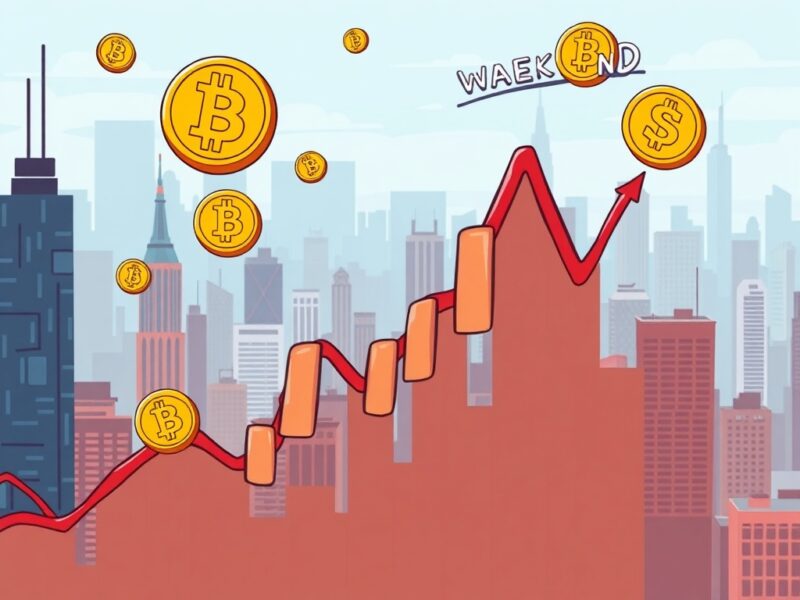Unlocking the CME Bitcoin Futures Gap: A Crucial Market Insight
0
0

BitcoinWorld

Unlocking the CME Bitcoin Futures Gap: A Crucial Market Insight
Ever wondered why the price of Bitcoin on the CME futures market sometimes takes a sudden jump or drop right at the start of the week? You’re witnessing a fascinating market phenomenon known as the CME Bitcoin futures gap. This past Monday, for instance, we saw a notable gap of approximately $1,280 as futures opened at $109,545, significantly above Friday’s close of $108,265. Understanding this gap is absolutely crucial for anyone tracking Bitcoin’s market movements.
What Exactly is a CME Bitcoin Futures Gap?
A CME Bitcoin futures gap occurs when the opening price of CME Bitcoin futures on Monday differs from its closing price on the preceding Friday. On a chart, this appears as an empty space between the Friday close and the Monday open. This difference isn’t arbitrary; it reflects significant price action in the Bitcoin spot market while traditional futures exchanges are closed.
The Chicago Mercantile Exchange (CME) adheres to traditional financial market hours, closing over weekends. However, the global Bitcoin spot market operates 24/7. So, if Bitcoin experiences a surge or dip between Friday evening and Monday morning, the CME futures market ‘catches up’ by opening at a price reflecting this weekend movement, thus creating the gap.
Why Do These Gaps Appear, and What Do They Tell Us?
The primary reason for a CME Bitcoin futures gap is the contrasting operating hours. This creates a unique dynamic, and the gap’s size often indicates Bitcoin’s weekend volatility. A larger gap suggests more significant price swings during the futures market’s non-trading hours.
For traders and analysts, these gaps are often considered important market signals. Many believe these gaps tend to “fill” over time, meaning the futures price will eventually move back to cover the gap’s range. This theory forms a cornerstone for certain trading strategies.
- Weekend Volatility Indicator: A wide gap signals substantial weekend price action.
- Potential Price Magnets: Gaps are often seen as areas where the price might eventually return.
- Trader Sentiment: The gap’s direction reflects overall market sentiment entering the new week.
Navigating the CME Bitcoin Futures Gap: Trader Strategies
The concept of a CME Bitcoin futures gap filling is popular among traders. This doesn’t mean it always happens quickly or directly, but the idea is that market forces often pull the price back towards the ‘uncovered’ territory. For example, an upward gap might lead some traders to anticipate a future price dip to fill that void.
However, “gap filling” isn’t a guaranteed event or precise timeline. While historical data shows a tendency, market conditions can change. Traders often combine gap analysis with other technical indicators and fundamental analysis for informed decisions.
Here are some ways traders might approach these gaps:
- Gap Fade Strategy: Betting against the gap’s direction, anticipating a fill.
- Momentum Trading: Riding the initial momentum created by a substantial gap.
- Confirmation Bias: Using the gap as an additional data point to confirm existing biases.
Understanding the Risks and Rewards of Gap Trading
Trading around a CME Bitcoin futures gap comes with challenges. The crypto market is inherently volatile, and Bitcoin’s price is influenced by many factors beyond technical patterns. Unexpected news or macroeconomic events can easily override the tendency for a gap to fill.
Key Considerations:
- Market Volatility: Bitcoin’s price can move dramatically, making gap trading unpredictable.
- No Guarantees: Not all gaps fill, and some might take considerable time.
- Leverage Risks: Futures trading often involves leverage, amplifying both potential gains and losses.
Investors must exercise caution, employ robust risk management, and never invest more than they can afford to lose. Thorough research and a clear understanding of market dynamics are paramount.
The Bigger Picture: CME Bitcoin Futures Gap and Market Insights
The existence and behavior of the CME Bitcoin futures gap offer a fascinating window into the evolving relationship between traditional finance and decentralized crypto. It highlights how institutional interest, via the CME, interacts with Bitcoin’s continuous, global trading. As the crypto market matures, understanding these unique interactions becomes increasingly important.
These gaps serve as a regular reminder of Bitcoin’s distinct market structure and its susceptibility to weekend price action. Monitoring these opening gaps can provide valuable insights into market sentiment and potential short-term price movements, even if they don’t always lead to immediate “gap fills.”
In conclusion, the CME Bitcoin futures gap is a distinctive feature of the Bitcoin market, stemming from the differing operational hours of traditional and crypto exchanges. While it offers intriguing possibilities for traders, it also underscores the importance of nuanced market understanding and prudent risk management. By staying informed about these gaps, you gain deeper insight into Bitcoin’s unique market behavior and can better navigate its often-volatile landscape.
Frequently Asked Questions (FAQs)
Q1: What does it mean for a CME Bitcoin futures gap to “fill”?
A1: When a CME Bitcoin futures gap “fills,” it means the price of the futures contract eventually moves back to trade within the price range that was skipped over during the weekend closure. For example, if there was an upward gap, the price would dip back down to the Friday closing level.
Q2: Do all CME Bitcoin futures gaps eventually fill?
A2: While there’s a historical tendency for gaps to fill, it’s not a guarantee. Market conditions, new developments, and overall sentiment can influence whether and when a gap might fill. It’s a pattern, not a certainty.
Q3: Why is the CME closed on weekends while Bitcoin trades 24/7?
A3: The CME is a traditional financial exchange that operates on standard weekday business hours, similar to stock markets. Bitcoin, being a decentralized digital asset, trades globally and continuously across various exchanges, creating the discrepancy.
Q4: How can traders use the CME Bitcoin futures gap in their strategy?
A4: Some traders use the gap as an indicator for potential price reversals, betting that the price will move to fill the gap. Others might use it to gauge weekend volatility or as a confirmation for other technical analyses. However, it should always be combined with comprehensive risk management.
Q5: Is trading the CME Bitcoin futures gap risky?
A5: Yes, like all forms of cryptocurrency trading, it carries significant risk. Bitcoin’s high volatility means prices can move sharply, and “gap filling” is not guaranteed. Leverage in futures trading can amplify both gains and losses, making robust risk management essential.
Did you find this deep dive into the CME Bitcoin futures gap insightful? Share this article with your fellow crypto enthusiasts and traders to spread awareness about this unique market phenomenon! Your insights can help others navigate the dynamic world of Bitcoin futures.
To learn more about the latest crypto market trends, explore our article on key developments shaping Bitcoin’s price action.
This post Unlocking the CME Bitcoin Futures Gap: A Crucial Market Insight first appeared on BitcoinWorld and is written by Editorial Team
0
0
 Manage all your crypto, NFT and DeFi from one place
Manage all your crypto, NFT and DeFi from one placeSecurely connect the portfolio you’re using to start.






